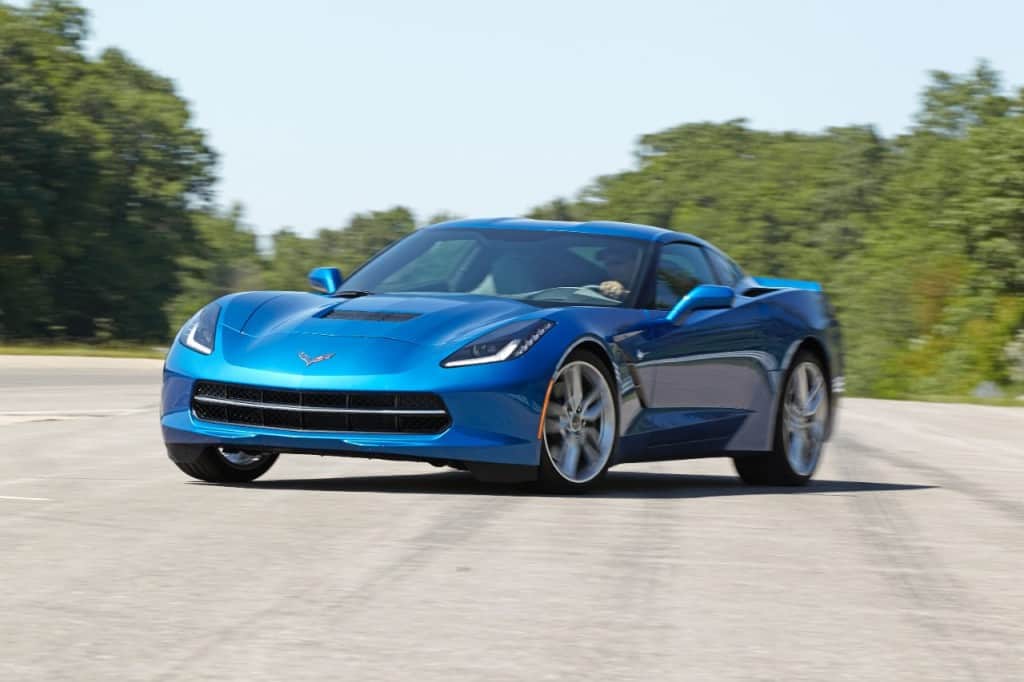For once, there is no rush. The cruise is set at 72 mph, and the dash, set to info mode, informs that mileage is hovering a bit over 30MPG. In a 4 cylinder Chevy, that’s expected stuff… but this is not a typical inline 4 Chevy! It’s a V4. A V4? A V4?? And there are 4 OTHER slugs riding along lazily, currently ingition-less but poised to add their considerable potential to the situation, should the need arise to, say, reach 60 MPH from a standing start in 3.9 seconds. Or to double the double nickle in about 12 seconds…in third gear! Or to threaten the double century. No this isn’t any run of the mill Chevy, rather, it’s an American Superhero, the 2015 Corvette Stingray convertible.
 Who’s to thank for this dichotomy? I’d submit it’s two rather unrelated and somewhat ironic events. 55 years ago or so, Jack Kirby, then working at Texas Instruments, figured out how to place transistors on a bit of semiconductor material, and the integrated circuit was born. Jack had a few transistors on his first ‘chips’, but by 2008, chips contained billions. The second, more nefarious, is typified by the Lehmen Brothers and the 2008 financial markets collapse that sent GM to Congress begging for help. GM was really up against the wall, and finally, desperate measures were taken. Actual middle management wood was pruned heavily. Divisions were flushed. Shorn of it’s resource consuming yet ineffective personnel, money could go where it belonged: into the actual product. Sit in a Corvette, and you can physically touch the effects of the 2008 debacle. What was once the worlds laughing stock, an interior that GM lamely defended for decades, has arisen like a Phoenix and is now top notch. No, it’s not a top line Audi S8 interior, but it’s not meant to be, nor is that appropriate. The seats are shining examples of how actual budgets, and letting a lean, focused team get on with it’s job makes for better product. As a matter of fact, the same should be said for the whole car.
Who’s to thank for this dichotomy? I’d submit it’s two rather unrelated and somewhat ironic events. 55 years ago or so, Jack Kirby, then working at Texas Instruments, figured out how to place transistors on a bit of semiconductor material, and the integrated circuit was born. Jack had a few transistors on his first ‘chips’, but by 2008, chips contained billions. The second, more nefarious, is typified by the Lehmen Brothers and the 2008 financial markets collapse that sent GM to Congress begging for help. GM was really up against the wall, and finally, desperate measures were taken. Actual middle management wood was pruned heavily. Divisions were flushed. Shorn of it’s resource consuming yet ineffective personnel, money could go where it belonged: into the actual product. Sit in a Corvette, and you can physically touch the effects of the 2008 debacle. What was once the worlds laughing stock, an interior that GM lamely defended for decades, has arisen like a Phoenix and is now top notch. No, it’s not a top line Audi S8 interior, but it’s not meant to be, nor is that appropriate. The seats are shining examples of how actual budgets, and letting a lean, focused team get on with it’s job makes for better product. As a matter of fact, the same should be said for the whole car.
It’s hard to imagine that Jack Kirby had any inkling of the long term ramifications of his experimental chip. Granted, Jack was only one of several players in the transition from discreet bulky circuits to the complex, impossibly small, impossibly fast, and impossibly complex chip that powers everything we put our hands on, from the refrigerator compressor to the differential in the new Stingray. Now, maybe Mr. Moore had an inkling of what kind of transistor density, processing speeds and storage capabilities we’d be dealing with, as Moore’s law has remained pretty accurate far after most said it would, but nobody could have predicted the performance effect the IC chip would have on the big, brawny, lumpy, fuel flushing, teeth rattling V8s of the 60’s. The motor in today’s Stingray can go from a sleeping kitten to an enraged, roaring lion in full attack with the twist of a knob. And get triple the mileage of it’s early corporate brothers.
At 7AM on a sweltering Sunday, slip into the air conditioned seats, start up in Touring mode, making barely a whisper, and idle quietly out the cul de sac. Pick up the pace a bit through town, watching the display showing tire temps as they warm. Slip onto the highway, easing through traffic nearly unnoticed, and certainly unheard. Approach a tunnel, find a gap in traffic, slow to 40 or so, slip into 2nd, twist the Mode knob to either Sport or Race, and mat it. Instantly the tunnel walls scream back a V8 bellow that grows to nearly as shriek as it rips to redline. Tug the direct, short throw shifter, and you’re in 3rd. The revs climb a bit slower now as the speedo flashes by too fast to read the single digits, and the engine takes on the sound of a Daytona Prototype racer. As the tunnel ends, the speed is well over 100, and it’s time for 4th. Then back to 3rd quickly for the fast approaching exit, letting the rev match feature blip the throttle for you. Point it at the apex, while still braking heavily. No worries about any weird behaviors, the E diff controller is tracking your every move, knows the steering input, the Gs, and even the tire temps, and opens and closes the clutches as appropriate. So, no big understeer entering, and no spinning inside tire getting out of the corner either. Neither is remarkable, but having both, well, that’s the trick. Ask any racer who sets his diff’s clutch pack by hand, and watch his eyes light up when you suggest that with the E diff, you really can have your cake and eat it too. Chips, man, fast processing chips.
No single aspect of the above scenario is really that remarkable. Big HP cars have existed for a long time. Spectacular handling traits and high cornering Gs have been around forever. Cars getting really good mileage? State your favorite MPG champ, and your friend will trump you with something older. And comfort? We Americans have been the king of air conditioned comfort since before most of us were born. But not until the C7 Stingray has there been such a convincing combination of a car that can do it all. Mild mannered by day, yet able to leap tall buildings in a single bound. Thanks Jack! And even you, Lehman Brothers and your types… I never would have guessed that those events would have been pivotal in making the Corvette a legitimate world player in the big dog sports car market, but, it’s here, it’s legit, and you, reader, need to get your hands on the wheel of one.
Likes:
Exhaust note at startup.
Ride quality and damper settings.
Interior
The view over the hood and fenders.
The seats, finally!
The attention, nothing but thumbs ups
Pans:
The overly sprung or is it locked out shifter that resists 2nd gear.
The attention.
And, a quibble: not enough exhaust burble on the overrun.
 Who’s to thank for this dichotomy? I’d submit it’s two rather unrelated and somewhat ironic events. 55 years ago or so, Jack Kirby, then working at Texas Instruments, figured out how to place transistors on a bit of semiconductor material, and the integrated circuit was born. Jack had a few transistors on his first ‘chips’, but by 2008, chips contained billions. The second, more nefarious, is typified by the Lehmen Brothers and the 2008 financial markets collapse that sent GM to Congress begging for help. GM was really up against the wall, and finally, desperate measures were taken. Actual middle management wood was pruned heavily. Divisions were flushed. Shorn of it’s resource consuming yet ineffective personnel, money could go where it belonged: into the actual product. Sit in a Corvette, and you can physically touch the effects of the 2008 debacle. What was once the worlds laughing stock, an interior that GM lamely defended for decades, has arisen like a Phoenix and is now top notch. No, it’s not a top line Audi S8 interior, but it’s not meant to be, nor is that appropriate. The seats are shining examples of how actual budgets, and letting a lean, focused team get on with it’s job makes for better product. As a matter of fact, the same should be said for the whole car.
Who’s to thank for this dichotomy? I’d submit it’s two rather unrelated and somewhat ironic events. 55 years ago or so, Jack Kirby, then working at Texas Instruments, figured out how to place transistors on a bit of semiconductor material, and the integrated circuit was born. Jack had a few transistors on his first ‘chips’, but by 2008, chips contained billions. The second, more nefarious, is typified by the Lehmen Brothers and the 2008 financial markets collapse that sent GM to Congress begging for help. GM was really up against the wall, and finally, desperate measures were taken. Actual middle management wood was pruned heavily. Divisions were flushed. Shorn of it’s resource consuming yet ineffective personnel, money could go where it belonged: into the actual product. Sit in a Corvette, and you can physically touch the effects of the 2008 debacle. What was once the worlds laughing stock, an interior that GM lamely defended for decades, has arisen like a Phoenix and is now top notch. No, it’s not a top line Audi S8 interior, but it’s not meant to be, nor is that appropriate. The seats are shining examples of how actual budgets, and letting a lean, focused team get on with it’s job makes for better product. As a matter of fact, the same should be said for the whole car.

